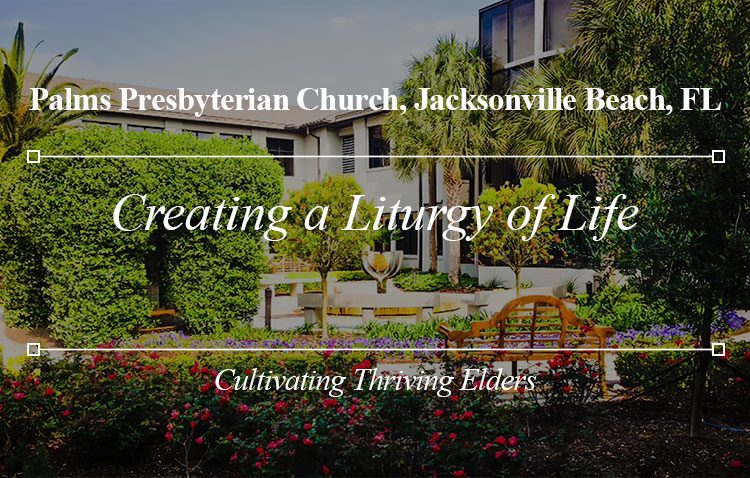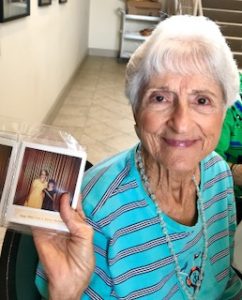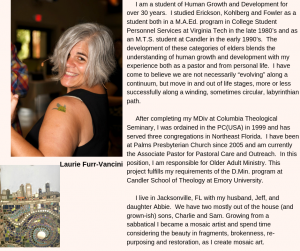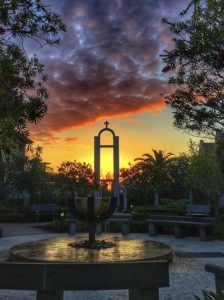Introduction
“I came that they may have life, and have it abundantly” (Jn 10:10)
Abundant life is NOT only for the young. Aging congregations are filled with older adults. If the incarnation of Jesus was to gift humanity with life abundant, then church should cultivate life abundant. To consider abundant life in the context of the church, we must see the people who seem to be living an abundant life, as well as those who do not. Who is thriving and who is not? The pastor, as leader, can envision a space into reality for church members to consider their ongoing call to life abundant. And, if a church has an abundance of older adults, life abundant would look like thriving older adults: thriving elders.
Project
What are marks of thriving elders? Can space be created to cultivate thriving elders? The dynamic interplay of individuals, church and pastor can be fertile ground allowing for stories, imagination, movement and engagement which, in turn, can allow for the flourishing of more individuals, for the pastor and for the church. If abundant life of flourishing is the desire of The Holy, then thriving at all ages, should be the work of the individual, the pastor, and the church. If we consider the entirety of our everyday life as opportunity for the life of abundance for which we are created, might we consider our life as worship? Is our everyday embodiment a liturgy of life?
What I Did And Who I Am
In the past year, I developed the following categories of elders: Thriving Elders, Self-Serving Elders, Embittered Elders, and Hidden Elders. Through research of source material and research of listening closely in the “Creating a Liturgy of Life” course, as well as from years of attentiveness in pastoral care with older adults, I discerned the categories of elders shown below.
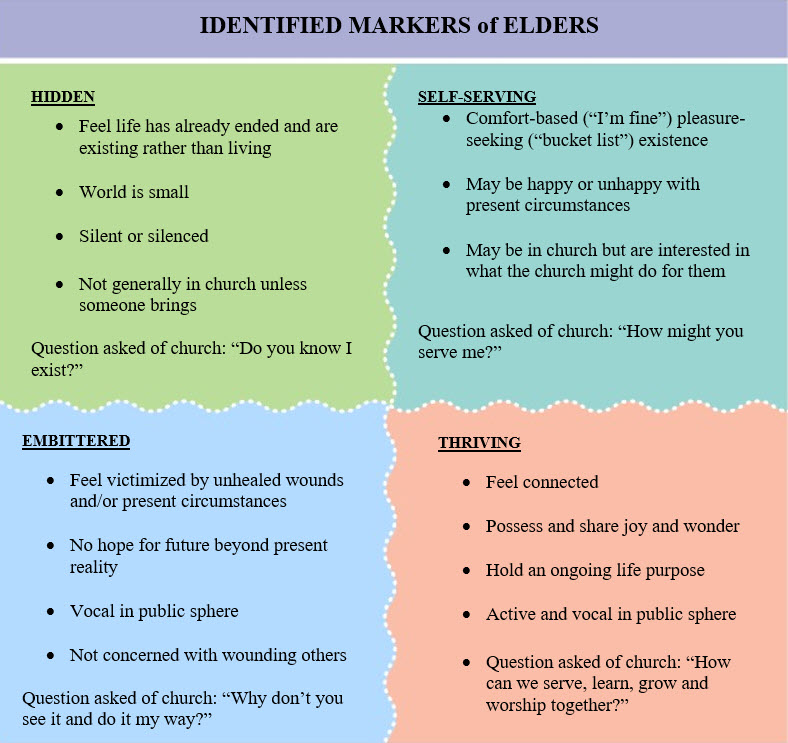 The categories of elders are fluid and permeable and, as stated, are not on a continuum. It is my belief that both Self-Serving and Embittered Elders have possibilities of moving in to or toward the category of Thriving Elders. With a catastrophic health event or the need to become a caretaker for a loved one, Thriving, Embittered and Self-Serving elders can all slip into the category of Hidden. Each of these categories holds implications for church and the larger society.
The categories of elders are fluid and permeable and, as stated, are not on a continuum. It is my belief that both Self-Serving and Embittered Elders have possibilities of moving in to or toward the category of Thriving Elders. With a catastrophic health event or the need to become a caretaker for a loved one, Thriving, Embittered and Self-Serving elders can all slip into the category of Hidden. Each of these categories holds implications for church and the larger society.
For the purpose of this project, Thriving Elders were the focus. I imagined Thriving Elders to be living into Jesus’ desire for life abundant for everyone. Cultivating Thriving Elders became both the goal and what was both looked for and hoped for in the course, “Creating a Liturgy of Life”.
Research Process
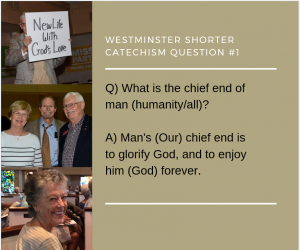 To consider this how thriving elderhood might be cultivated, I developed a course, “Creating a Liturgy of Life” based on question 1 of The Westminster Shorter Catechism (1) and the understanding that all life is worship (2). The class included narrative storytelling and spiritual companions as an experiment, based Karen Scheib’s research (3) around narrative storytelling.
To consider this how thriving elderhood might be cultivated, I developed a course, “Creating a Liturgy of Life” based on question 1 of The Westminster Shorter Catechism (1) and the understanding that all life is worship (2). The class included narrative storytelling and spiritual companions as an experiment, based Karen Scheib’s research (3) around narrative storytelling.
The focus on life liturgy provided a way to consider life narrative through the lens of the common experience, language, and pattern of worship. The course was part of a larger program development for an Older Adult Ministry at Palms, which included creating a data base system for tracking visitation and pastoral care needs, the creation of a part-time position of Older Adult Ministry Coordinator, and creation of a Steering Committee for Older Adult Ministry .
“Creating a Liturgy of Life” was a weekly three-month course that led participants to consider their life as worship, how their stories shape their lives, their relationship with God, and their relationships with others. Participants were paired and became Story Companions with whom they shared both stories and meals. In addition, I interviewed participants mid-course and the participants completed initial and end of course questionnaires.
Each class session was created to spur the spiritual imagination of participants and guide the class into discussions of faith and their understanding of God’s guidance through their lives; past, present and future. The goal was not a sentimental remembering, but a safe space for discernment; for prayer and praise; for thanksgiving and lament; for confession and redemption. Central was the desire to help participants name God’s grace at different points in their lives and now, and to cultivate relationships within the class. Throughout the three months, participants discerned and wrote their own life Call to Worship, Passing of the Peace, Prayer of Confession, Prayers of the People, Charge and Benediction. They chose scripture to guide the next part of their life and wrote and shared meditations. Music was an important piece of the class (as it is in Palms worship services). Each participant chose music for their service and a longer song list called “The Music of My Life”.
Through “Creating a Liturgy of Life’, a new way of being together at Palms was tested. Class participants created a life liturgy and entered in to a relationship with an individual who was their Spiritual Companion. In addition, participants practiced together the biblical mandate “love one another” (John 3:34) through listening to stories of others and sharing their own stories.
Findings
The individuals in the class were invited to consider their identity as worshiping beings in their everyday life. For most of them, even in their advanced age, this was a new idea which may remain with them for the rest of their lives.
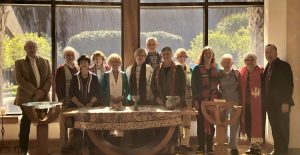 By working with the Liturgy of Life class participants, (hearing stories, considering written and spoken liturgies, reviewing three written evaluative pieces), a picture of THRIVING ELDERS became clearer. As a disclaimer and a blessing, I was intricately woven together with the individuals and the community which I was researching. I have served this congregation for twelve years and I have a broad understanding of the lives of individuals and the life of the congregation. I love these people and I love this congregation. Even as I name what I saw as “Marks of Thriving Elders”, it is my deep hope that each of the research subjects continue to thrive throughout their entire lifespan.
By working with the Liturgy of Life class participants, (hearing stories, considering written and spoken liturgies, reviewing three written evaluative pieces), a picture of THRIVING ELDERS became clearer. As a disclaimer and a blessing, I was intricately woven together with the individuals and the community which I was researching. I have served this congregation for twelve years and I have a broad understanding of the lives of individuals and the life of the congregation. I love these people and I love this congregation. Even as I name what I saw as “Marks of Thriving Elders”, it is my deep hope that each of the research subjects continue to thrive throughout their entire lifespan.
Thriving Elders Feel Connected
When considering connectedness, the important question is not to whom or what are thriving elders connected, but do they feel connected to someone(s) or something. Statements of connection include: I am connected to my family. I am connected to my faith community. I feel God’s presence most every day. I enjoy spending time outside. People like to be with me, and I like to be around people.
Thriving Elders Possess and Share Joy and Wonder
Possessing and sharing joy and wonder is another mark of thriving elders. They are noticers and namers themselves and call on others to see the joy and wonder that they see. Thriving elders can look back on their lives and name the presence of joy and wonder, even during difficult times. This joy and wonder can be loud and exuberant or quiet and contemplative. Thriving Elders seem to not only possess joy and wonder, but also share joy and wonder with others. Joy and wonder are woven together and gain strength, creating a fabric of resilience and power.
Possessing and sharing joy and wonder overlap with being connected and having an ongoing life purpose. The overlap indicates how Thriving Elders piece together their past in a way that continue to strengthen and make meaning in their present and continue to give them hope for the future.
Thriving Elders Hold an Ongoing Life Purpose
Thriving Elders do not feel that “my best years are behind me”. Thriving Elders understand themselves as learning and growing. As mentioned earlier, Thriving Elders remain curious. They do not think they have learned all there is to learn. They do understand what they have achieved in life, but a Thriving Elder might not hold the same definition for achievement as the larger society.
Future Implications
The interplay of individuals, pastor and church indicates that there is work to be done by the church, pastor and individuals to help elders thrive. In addition, as more elders thrive, there are implications for the church, the pastor and individuals as they harvest the gifts of thriving elders.
Churches
Consideration of Hidden Elders, Self-Serving Elders, and Embittered Elders should remain in the imagination of the entire church as classes, programs and small group opportunities are developed.
Q) What experiments like a Liturgy of Life class might your church create to be an intentional undertaking to share stories and pray together about aging?
Q) How might your congregation or the larger church consider the special needs faced and communal obstacles created by Hidden Elders, Self-Serving Elders and Embittered Elders?
Pastors
Though this project focused on cultivating Thriving Elders, persons in each of these categories deserve attention, through further research, pastoral care and outreach. Many elders live on the margins of society today and both the pastor and the church need to experiment with ways of bringing the love of Christ to them.
Q) As you look at the categories of Elders, do they seem to “fit” people whom you know? What, or who is missing?
Q) How do pastors who are spread thin and wide, care for different types of elders in our midst? How might cultivating thriving elders enable flourishing in the wider congregation? What might that look like in your congregation?
Individuals
Churches and pastors can encourage, plan, offer, and implement wonder-filled, Spirit-led offerings, and theologically-sound worship. However, if individual older adults are not willing to step in to a place of connection, wonder, and ongoing life purpose, the efforts to cultivate elders will fall flat.
As elders consider their life as worship, they can be encouraged to take a hard look at and responsibility for places and moments where past experiences and stories do not support their current life. Questions for individuals (including pastors) might begin with the following.
Q) Where and when have you represented AND not represented God who created you as loving, worshiping beings?
Q) How are you called now to live in to the ongoing love and redemption of Jesus?
Q)What new stories are necessary to support a life that glorifies God?
Q) If our chief end of life is “to glorify God and enjoy God forever”, what grace must be named and shared to make it so in our own lives and in the lives of others?
- Presbyterian Church (U.S.A.) The Constitution of the Presbyterian Church (U.S.A.). (Louisville, KY: Office of the General Assembly, 2014), 175.
- The idea of a Life Liturgy from classes on worship in the DMin program at Emory University Candler School of Theology taught by Dr. Don Saliers, Dr. Steffen Lösel, and Dr. Edward Phillips in the 2017-18 academic year.
- Karen Scheib, Pastoral Care: Telling the Stories of Our Lives. (Nashville: Abingdon Press, 2016), 61-78.
A brief video of how this project came together as part of the Candler D.Min. program (class of 2019)
